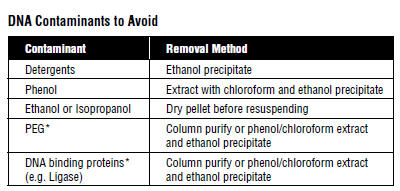High Efficiency Transformation Protocol for 96-well format (C2987P)
Protocol
Note: This is a protocol for C2987P.- Chill a metal 96-well block on ice.
- Remove the plate from -80°C freezer, and place in chilled metal 96- well block (or directly on ice) for 2 minutes to thaw the competent cells.
- Carefully remove the aluminum foil seal from the plate or pierce holes through the foil seal with pipette tips.
- Add 1-2 μl containing 1 pg-100 ng of plasmid DNA to the cell mixture using a multichannel pipette. Carefully swirl the tips to mix cells and DNA.
- Seal the plate with plate cover, or cap strips, or tapes.
- Incubate the plate in the chilled metal block (or on ice) for 20 minutes.
- Heat shock the cells at exactly 42°C for exactly 10 seconds by transferring the plate to a pre-warmed thermal block or water bath.
- Place in the chilled metal block (or on ice) for 2 minutes.
- Pipette 180 μl of room temperature SOC into each well.
- Place at 37°C for 60 minutes. Shaking is not necessary.
- Warm selection plates to 37°C.
- Mix the cells thoroughly by pipetting, then perform several 10-fold serial dilutions in SOC.
- Spread 50-100 μl of each dilution onto a selection plate and incubate overnight at 37°C.
Transformation Protocol Variables
Thawing: Cells are best thawed in chilled metal 96-well block and DNA added as soon as cells thawed (less than 2 minutes). Incubation of DNA with Cells on Ice: For maximum transformation efficiency, cells and DNA should be incubated together on ice for 20 minutes. Expect a 2-fold loss in transformation efficiency when this step is shortened to 2 minutes.
Heat Shock: Both the temperature and the timing of the heat shock step are important and specific to the transformation volume and vessel. Using the plate provided, 10 seconds at 42°C is optimal.
Outgrowth: Outgrowth at 37°C for 1 hour is best for cell recovery and for expression of antibiotic resistance. Expect a 2-fold loss in transformation efficiency for every 15 minutes this step is shortened. SOC gives 2-fold higher transformation efficiency than LB medium. Shaking is not necessary.
Plating: Selection plates can be used warm or cold, wet or dry without significantly affecting the transformation efficiency. However, warm, dry plates are easier to spread and allow for the most rapid colony formation.

